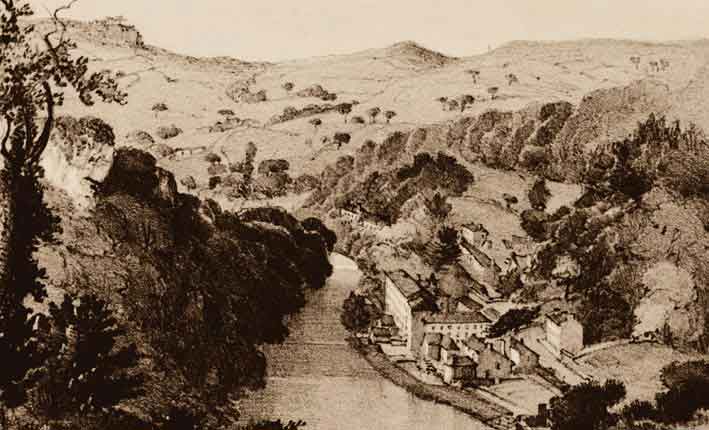For Gwen Wilson and Sukie Khaira, who work so hard for the Derwent Valley Mills World Heritage Site; also Tony and Vicki Brown, Pippa Mansel and George Jones, Adam Lathbury and Becky Waddington, for all their support and friendship; and for all the people who work or volunteer to make the valley the great place it is, not least my ever-patient wife, Mary.
Dedicated to the memory of William Wellington Rowland, the grandfather I never knew, killed in action at Esquelmes, Belgium, in May 1940, seventy-five years ago.
First published 2015
Amberley Publishing
The Hill, Stroud, Gloucestershire, GL5 4EP
www.amberley-books.com
Copyright Adrian Farmer, 2015
The right of Adrian Farmer to be identified as the Author of this work has been asserted in accordance with the Copyrights, Designs and Patents Act 1988.
ISBN 9781445615066 (PRINT)
ISBN 9781445615158 (eBOOK)
All rights reserved. No part of this book may be reprinted or reproduced or utilised in any form or by any electronic, mechanical or other means, now known or hereafter invented, including photocopying and recording, or in any information storage or retrieval system, without the permission in writing from the Publishers.
British Library Cataloguing in Publication Data.
A catalogue record for this book is available from the British Library.
Typesetting by Amberley Publishing.
Printed in Great Britain.
Table of Contents
Introduction
Derbyshires Derwent has, for centuries, been a hard-working river, driving waterwheels and later turbines to power some of the most important mills in world history. The 15-mile stretch from Matlock Bath to Derby is now regarded as the birthplace of the modern factory, playing a key role in the earliest stages of the Industrial Revolution. The mass-production achieved here during the eighteenth century, and the legacy of mills and communities still with us today, deservedly earned inscription on UNESCOs World Heritage List in 2001.
Although the eighteenth and nineteenth centuries were the glory days for the Derwent Valley Mills, there was still growth before the slow decline of the twentieth century. The cover view is a good example, with the Belper mills seen from the River Gardens, firstly c. 1908 when the pleasure grounds were still new, with the 1854 chimney standing alone, and the West Mills clock tower peeking out behind the North Mill. The modern view shows the chimney and clock tower have gone, but the mighty East Mill of 1912 has risen and can be seen beyond the bandstand part of the final expansion of the English Sewing Cotton Co. in the valley.
Music has been part of Belpers River Gardens since their inception in 1906. The bandstand has been well used throughout its life from early recitals, with listeners seated formally in a circle, to present-day summer concerts, with visitors sitting or standing where they like to hear all manner of musical entertainment.
A book of this size cannot cover every aspect of the Derwent Valley Mills and the communities around them, nor explain their significance (or even provide references). At best, its a taste of what can be found between Masson Mills at Matlock Bath and Derbys Silk Mill as you follow the Derwent from north to south.
One area that does receive a little more coverage is Belper partly because its my home turf, but it also gives me a chance to celebrate the towns 2014 win in the national Great British High Street Competition. The judges were impressed with the Belper Ambassador training sessions, which help shopworkers to better understand the town and its history. The chance to look at the past of what is now officially Britains best high street was too good to miss.
Of the challenges faced in developing this book, the greatest was taking the modern-day photographs the growth in size and number of trees has had a considerable impact on several important historic views, although its not just down to the trees. Its frustrating to have wonderful old images and not be able to use them. Equally frustrating, there are areas of heritage for which I cant find an old photograph!
For more on the World Heritage Site, a series of informative publications have been produced by the Derwent Valley Mills Educational Trust, the latest of which Cromford Revisited is a particular mine of information. Theres also a website www.derwentvalleymills.org. Theyre well worth seeking out, once this book has, hopefully, given you a taste for this fascinating, historic valley.
Acknowledgements
For guidance, information, photographs and proofreading, Id whole-heartedly like to thank the following people: Mary McLean-Farmer, the late Tom Alton, Anthony Attwood, Ian Barlow, Annie Bird, Tony Bowker, Iain Campbell, Peter Davies, Heather Eaton, Christine Erratt, Richard Fletcher, Alan Foord, Don Gwinnett, Roy Hartle, Malcolm Hill, the late Marion Holden and family, David Jennison, George Jones and Pippa Mansel, Barry Joyce, Pam and John Lloyd, Sarah McLeod and the Arkwright Society, Jane Middleton-Smith and the John Smedley archivists, Patrick Morriss, Hugh Potter and the Friends of Cromford Canal, Richard Pinkett, Lin and Michael Ryan, Mary Smedley, Ben Spiller, Tim and Caroline Sutton, the late Eric Swain, Tim Tomlinson, Gwen Wilson and The Derwent Valley Mills World Heritage Site Research and Publications Panel.
Masson Mills Before Expansion
The building of the later mills, and heightening and realignment of the road, make a modern interpretation of this view of Masson Mills virtually impossible, although there are similarities to the earlier photographs on page 7. The chimney of 1900 has been built, and the gassing mill (left of the chimney) modernised, but the cottage in the foreground has not yet been demolished for the building of the Glenn Mill in 1911. The buildings on the left were also demolished when the road was realigned.
Masson Mills from Wildcat Crags
The Wildcat Crags above Matlock Bath provide a wonderful view into the Derwent Valley Mills World Heritage Site from the north, looking down on Sir Richard Arkwrights Masson Mills by the river. The addition of the chimney and, beyond, the larger mills with tower, make the cluster of buildings look quite different today, compared to the mid-nineteenth-century print above. At the top left you can now also see the expanded village of Cromford and nearby quarries.
Building the Masson Tower
In 1911, the English Sewing Cotton Co. an 1897 amalgamation of fourteen companies, including the Arkwright and Strutt empires which transformed textile production in the eighteenth century brought further investment to its mills at Masson. Above, the Glenn Mill is nearing completion, while the tower is taking shape. As can be seen from the modern view below, a further mill was built, now used as a car park for the shopping village housed in the Glenn Mill.



















